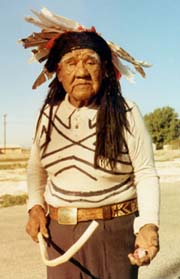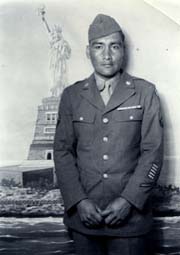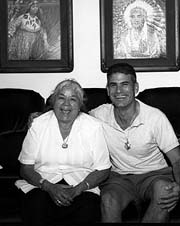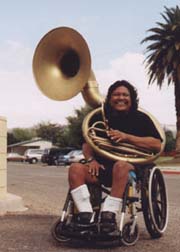               
|
 |
House of Night:
The Lost Creation Songs of the Mohave People
Produced by The Kitchen Sisters, Davia Nelson & Nikki Silva
w/ Jim Mckee at Earwax Productions

Emmett Van Fleet with an old-time Mojave shinny stick and ball he made--the last time he played the game was 1924. Arizona
December 18, 1972.
Photograph by Guy Tyler.
|
Listen with RealAudio in
14.4,
28.8,
or G2 SureStream.
Look at the House of Night Photo Gallery.
Read a listing of Credits & Acknowledgements.
Read about the Storyscape Project.
Thirty years ago, a CBS radio engineer out of Los Angeles, with his
portable reel-to-reel drove out to the Colorado River Indian Reservation
in Parker, Arizona looking to make Mojave recordings. There he met Emmet
Van Fleet, an elder of the tribe and the last of the Creation Song
signers. Over the course of several years, Tyler made his weekend
pilgrimages, and slowly and meticulously the two men recorded the 525
song cycle that recounts the legend of the creation and origin of the
Mohave people, their oral maps, the mythological journeys of legendary
figures, descriptions of their sacred sites, and the stories behind
them, directions to safely cross the Mohave desert, the story of how
fire was brought to them.
This story was brought to us this summer by Bay Area
writer/poet/environmental activist and Director of the Storyscape
Project Philip Klasky. Klasky has devoted many years to the Ward Valley
struggle and the cultural preservation of the native languages and
history of the Mohave and the western Shoshone.

Army Lew in front of the Statue of Liberty photo backdrop.
Photo Courtesy of Llewellyn and Betty Barrackman.
|
Lost & Found Sound looks at these creation songs, their meaning
to the Mohave, the passing on of the oral tradition within the tribe and
how the language, songs and traditions are in danger of extinction in
this modern world. We explore the relationship of Guy Tyler and
Emmet Van Fleet----a white sound engineer from LA and a Mohave elder, in
the context of the tradition of ethnographer and native culture. We
also look at Phil Klasky, as a kind of second generation,
turn-of-this-century Guy Tyler, who has also entered the culture and
trust of the tribe to continue the work of preservation and
presentation.
The revealing of these tapes have led to the revitalization of the
recounting and retelling of these Creation song cycles and the Mohave
language, and the ability of the elders to pass down to the next
generation the powerful and mythical lessons and legends that are their
birthright and the instructions of traditional Mohave death rituals by
the example of the great God Mutavilya's own death and creation. Our
story will explore the role sound, story and legend play in the
preservation of culture and political organization.

Betty Barrackman in her living room with Philip Klasky.
Needles, Ca July 11, 1999.
Photograph by Sandra Wong Geroux.
|
Through these song cycles captured in the Van Fleet recordings the
Mohave describe the traditional travels of the Mohave along the Colorado
River from Avi Kwa Me or Spirit Mountain, to Avi Kwahath or Greasy
Mountain. When action started being taken to turn the scared Silyaye
Ahease or Ward Valley into a nuclear waste dump in 1995, the Mohave and
other Colorado River Tribes were able look to these Creation songs to
re-affirmed their belief that they were put on this land by the creator
to protect and safeguard this land. This connection between land and
people and song is what eventually saved the endangered Ward Valley and
Colorado River. Llewellyn Barrackman explains, "The Mojave have no
place to go. This is our home. We are the Pipa Aha Macav, the people
along the river, instructed by the creator to protect it."
Lost & Found Sound took a trip to the Mojave Indian
Reservation to meet with the elders of the Mojave tribe, the birdsong
singers and activists in the Ward Valley struggle. In the course of our
initial interviews with elder Llewellyn Barrackman and his wife Betty,
they pulled out an old photograph and an old tape and began to tell us a
story from Llewellyn's painful childhood memories of growing up on the
Fort Mojave reservation.

Steve Lopez, Ft. Mojave Tribe, Needles CA July 12, 1999.
Photo by Sandra Wong Geroux.
|
Needles, California at the turn-of-the-century was a booming train town
for all coming West. As the whites filed off the train into their town,
the Mojave people would line the tracks to sell their pottery, souvenirs
and food. Oftentimes these newcomers would taunt and humiliate the
tribespeople by pulling their braids, kicking over their baskets and
mocking their language. The Mojave, who spoke little English, looked for
a way to reclaim their dignity and a way to communicate to these new
people. They found the solution in the universal language of music. So
began the long and little documented history of the Fort Mojave Marching
Band. Founded in 1906 by a German professor who had played with John
Phillip Sousa's band, the direction of band was soon turned over to Ned
White, a Mojave Indian. The band quickly became famous for its lively
and well played marches and for winning all the local competitions.
After telling the history of the marching band, Mr. Barrackman led us
down the street to their gymnasium where the band rehearsals, full of
eager young people, were still going loud, strong and in full swing. At
the turn of the last century 24 tribal marching band flourished, at the
turn of this century there are only two-The Zuni and the Fort Mojave,
who youngest member is 7 years old and the oldest, tribal elder
Llewellyn Barrackman is 82.
You need the free RealAudio player to listen to audio files.
Copyright © 2000 The Kitchen Sisters
|
|
|

